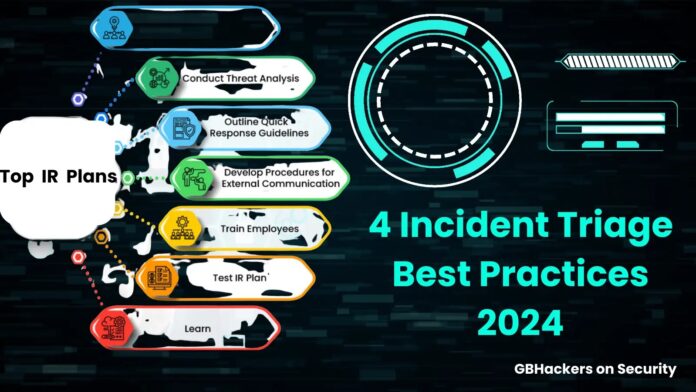[ad_1]
Maintaining uninterrupted services is vital for any organization.
The backbone of ensuring this continuous uptime lies in the Incident Management process. Incident triage is a significant component of this process.
It enables organizations to prioritize and address potential incidents efficiently.
In this article, we’ll look into the elements of incident triage and outline best practices to streamline your organization’s incident response.
Incidents, ranging from minor glitches to critical outages, can disrupt operations and impact customer experience.
To mitigate these disruptions effectively, organizations must implement active Incident Management processes.
By identifying and addressing issues, organizations can minimize downtime, uphold service reliability, and safeguard their reputation.
How Incident Triage Works
To understand how incident triage works, it starts the moment a potential issue arises, prompting responders to assess its severity and determine the appropriate course of action.
This initial evaluation distinguishes between mere anomalies and genuine incidents, guiding subsequent response efforts.
So, through meticulous analysis and classification, organizations can optimize resource allocation and speed up incident resolution.
The Incident Lifecycle
Incident Detection & Classification
The first step in incident triage involves detecting and accurately classifying incoming alerts. It establishes predefined data fields and event tags and facilitates automated classification, reducing manual intervention and response times.
Moreover, it implements deduplication rules to prevent notification overload, ensuring that responders focus on unique incidents.
It also furnishes essential details and filters out irrelevant information, which helps organizations streamline the triage process and enhance operational efficiency.
Incident Alerting
Effective incident alerting hinges on delivering timely notifications for actionable events while mitigating alert fatigue.
Configuring deduplication and suppression rules prevents redundant alerts, enabling responders to prioritize critical incidents.
So, by optimizing alerting mechanisms, organizations cultivate a responsive incident management ecosystem conducive to swift resolution and minimal service disruption.
Incident Prioritization
Prioritizing incidents based on their impact and urgency is paramount for efficient triage and resource allocation.
Automated prioritization mechanisms, aligned with service and customer impact metrics, expedite incident handling and resolution.
So, an organization that equips responders with clear directives and contextual insights will optimize incident triage workflows and uphold service excellence.
Triage and Collaboration
Logical collaboration and streamlined communication are indispensable for effective incident triage and resolution.
Configuring incident routing and escalation policies ensures that incidents reach the appropriate responders promptly.
Leveraging platform-specific collaboration tools like Radiants Security will foster real-time communication and knowledge sharing, enhancing team cohesion and decision-making agility.
Incident Communication
Transparent and active communication is essential for managing stakeholder expectations and maintaining trust during incidents.
Automating communication updates and providing stakeholders with real-time insights fosters transparency and accountability.
Furthermore, maintaining a public status page facilitates active customer engagement and augments organizational resilience to disruptions.
Incident Resolution
Automation and documentation are cornerstones of efficient incident resolution processes.
Integrating incident management tools enables the execution of remedial actions, minimizing manual intervention and accelerating resolution.
So, documenting resolution efforts and maintaining comprehensive incident records empower organizations to derive insights and refine response strategies iteratively.
Incident Review & Remediation
Post-incident review and remediation are integral to continuous improvement and resilience enhancement.
Collaborative incident reviews, coupled with root-cause analysis, explain underlying issues and inform preventive measures.
Embracing a blameless culture fosters open dialogue and knowledge sharing, fostering a culture of continuous learning and innovation.
Extending Incident Triage Practices
As organizations innovate, so do the challenges they face in incident management.
To stay ahead of the curve, continually refining and expanding incident triage practices is essential.
Here are additional strategies to augment your incident response capabilities:
1. Advanced Automation
Harness the power of artificial intelligence and machine learning to automate complex incident detection and resolution tasks.
Implement predictive analytics algorithms to anticipate potential issues before they escalate, enabling active intervention and risk mitigation.
Leveraging cutting-edge automation technologies will enable organizations to enhance operational efficiency and resilience in the face of conventional threats.
2. Cross-Functional Training
Provide cross-functional training to incident response teams to foster a culture of collaboration and knowledge sharing.
Equip team members with an understanding of organizational systems and processes, enabling them to collaborate effectively across departments during incident triage and resolution.
By breaking down silos and promoting interdisciplinary cooperation, organizations can optimize incident response efforts and minimize disruptions.
3. Continuous Evaluation and Optimization
Assess incident triage processes and performance metrics regularly to identify areas for improvement.
Solicit feedback from frontline responders and stakeholders to gain insights into pain points and emerging challenges.
Iterate incident response workflows based on lessons learned from past incidents and industry best practices.
By embracing a culture of continuous evaluation and optimization, organizations can adapt and evolve their incident management capabilities to meet threats and business requirements.
4. Stakeholder Engagement
Engage stakeholders proactively throughout the incident triage and resolution process to manage expectations and maintain transparency.
Provide regular updates on incident status and mitigation efforts to internal teams, customers, and other relevant stakeholders.
Solicit stakeholder input and feedback to ensure that incident response efforts align with business priorities and customer needs.
Conclusion
Mastering incident triage is essential for organizations seeking to enhance their Incident Management capabilities and boost resilience against potential disruptions.
Organizations can effectively identify, prioritize, and resolve incidents by implementing best practices and leveraging advanced technologies like Radiants Security, ensuring uninterrupted service delivery and maintaining customer trust in today’s digital space.
Stay updated on Cybersecurity news, Whitepapers, and Infographics. Follow us on LinkedIn & Twitter.
[ad_2]
Source link
